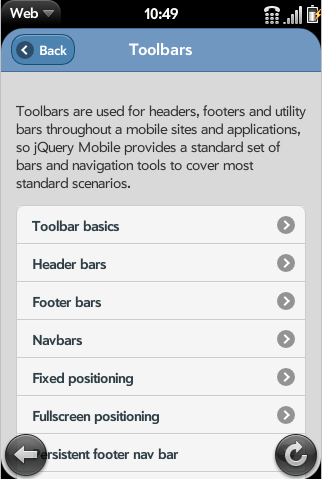According to an official note at http://www.jquerymobile.com:
jQuery Mobile is a unified user interface system across all popular mobile device platforms, built on the rock-solid jQuery and jQuery UI foundation. Its lightweight code is built with progressive enhancement, and has a flexible, easily themeable design.
To understand jQuery Mobile, it is very important to know what it is not.
- jQuery Mobile is not a jQuery alternative for mobile browsers.
To use jQuery Mobile, you need to include the typical jQuery framework. It is not a replacement; it is a UI layer on top of jQuery.
- jQuery Mobile is not a webapp SDK.
You can create the whole mobile experience with jQuery Mobile but you will need some additional work to compile it as native apps. We will see how, why, and when to do this in the next chapters.
- jQuery Mobile is not a framework for JavaScript lovers.
Except in the case of certain advanced topics, you wonât need any JavaScript code for jQuery Mobile to work. That is great if you are a web designer who hates all of those braces and semicolons.
- jQuery Mobile is not the solution for all mobile applications, websites, or games.
However, it covers solutions for most of them. For the others, wellâ¦I have to convince you to read my other book somehow.
If you donât know what jQuery is, you may be a time traveler from 10 years in the past. If you are Marty McFly, point your browser to http://jquery.com and read about this incredibly useful JavaScript framework, the most used one on the Web since 2007.
jQuery Mobile is a framework that delivers webapp experiences to mobile and tablet devices, mainly with touch interfaces, effortlessly, across multiple platforms, and using only HTML5 standard code. A jQuery Mobile app looks like Figure 1-2.
Figure 1-2. A typical jQuery Mobile webapp with standard theming in smartphones, a webOS device in this case
The platform uses the jQuery âcoreâ framework, a JavaScript library, a CSS 3 stylesheet, and some resource images.
jQuery Mobile is comparable to jQuery UI on the desktop side: itâs just a UI framework. The name (without any UI inside) leaves you to wonder whether itâs a core framework; but I believe the decision was made to take advantage of the power of the jQuery trademark inside the designer and developer world.
Tip
The framework was created by the same team as the main jQuery framework, whose leader is John Resig, JavaScript Tool developer for the Mozilla Corporation (@jeresig on Twitter).
This new platform, like jQuery and jQuery UI, was released as an open source project under a dual license MIT or GPL version 2.
Tip
If you want to participate in the development, you can provide patches, fix bugs, participate in the discussion, and work over the active live code on http://jquerymobile.com/contribute.
Get jQuery Mobile: Up and Running now with the O’Reilly learning platform.
O’Reilly members experience books, live events, courses curated by job role, and more from O’Reilly and nearly 200 top publishers.


